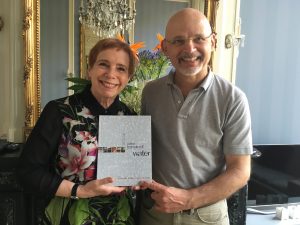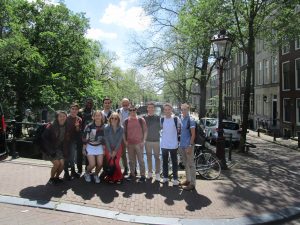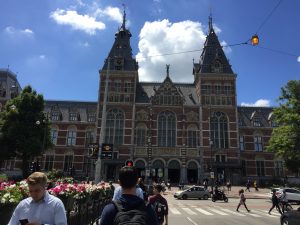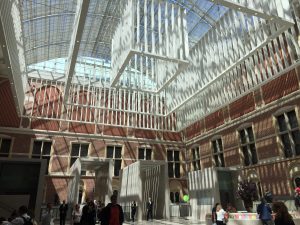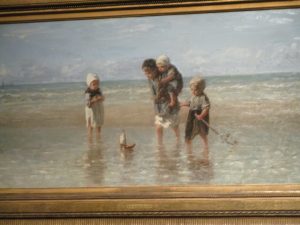The first morning of our trip started off early for many of us with jetlag, but our first meeting in Amsterdam did not feel tiring at all, thanks to Marjan Minnesema, the founder of Urgenda. We took a bus to arrive at an old Amsterdam bottling factory converted into a two-story office building and were directed to the second-floor meeting room. While a little late, Marjan made up for her tardiness with an impressive amount of pep, energy, and passion.
So, who is Marjan Minnesma and why was Professor Richter so excited about meeting her? Have you heard of the Dutch Climate Case? In 2013, a small NGO by the name of Urgenda (urgent + agenda), sued the Dutch government for not reducing green house gases vigorously enough to fulfill “its duty of care towards Dutch society.” And in 2015, the Dutch court ruled that Urgenda was right and ordered the Dutch government to set more ambitious goals. Marjan is a “live wire,” bristling with energy, ideas, and the will to create change. She keeps Urgenda small, “flat and unbureaucratic” so that it can nimbly focus on finding the exact point to apply pressure and to break through log jams that hinder the achievement of sustainability.
Marjan provided an interesting contrast of stories relating to her time at Urgenda, stories that were uplifting and stories (or facts) that were somewhat upsetting, especially to millennials. She told a story about how a number of years ago she circumvented Dutch bureaucracy in order to jumpstart the installation of solar panels on residential homes by figuring out a way to bring down the price. She rounded up 50,000 households prepared to provide a substantial downpayment and negotiated a reasonable price with a Chinese manufacturer. When Dutch banks were wary of her, she flew to China and found a bank there to provide a bridge loan. With her Dutch clients faithfully waiting, she organized the shipment and truck delivery to their homes.
This story about Marjan traveling to China to purchase solar panels was both entertaining and optimistic, but my main takeaway was that almost all of her customers in The Netherlands continued to have optimism in the benefits of solar energy, despite delays with Dutch banks and finding lorries for delivery. However, we also learned about the dire consequences from not changing our climate policies on the global scale. It is clear that Urgenda has done a great job of stressing the necessities of sustainability to the Dutch government, but they also stressed to us the serious consequences of rising temperatures. We learned that even a slight increase in global temperatures would cause a possible 600 million refugees, forced to leave their countries because of droughts, storms, and other natural disasters, creating a crisis much more dire than the current Syrian refugee crisis.
Marjan and Urgenda are an interesting model for urgent climate action. They finish a project and move on. When she speaks publicly, she spends a third of her time on the climate crisis and two-thirds on solutions. Marjan is indomitable and inspiring. She’s scored successes with Philipps, the electronics firm, and Albert Hein, the largest grocery store chain, which has pledged to make their stores carbon-neutral. We left Urgenda completely exhilarated.
Following our morning meeting at Urgenda, we traveled to the home of Tracy Metz, author of Sweet and Salt: Water and the Dutch, one of the books we read in preparation for the trip. Tracy is an American-born journalist with a focus on urbanism and design in the Netherlands. She has her own radio show and directs the John Adams Institute. As we entered Tracy’s home, settled on one of the most desirable residential streets in Amsterdam, a few houses down from the residence of the Lord Mayor of Amsterdam, we were brought into a blue room/office with a 5+ meter ceiling covered with a beautiful seventeenth-century painting of exotic birds peering down into the room. Under their watchful gaze, Tracy discussed with us many of the details relating to Dutch water management. One thing I picked up on was her habitual use of the word “we” when describing the Dutch people, even though she is originally from Los Angeles. In my opinion, it was clear to me that she identified more strongly with the culture of Amsterdam than she ever did with American culture—she specifically pointed out that the more compact layout of Amsterdam encouraged more social interactions and less individualism.
To me, Tracy’s thoughts and sentiments also reflect the greater contrast in the cultures of the Netherlands compared to the United States. The Netherlands encourages a culture of community, long-term well-being, prevention of disaster, and sacrifice for the greater good. It seemed that Tracy (and many Dutch citizens) find value in being a part of something greater than them, and that they trust and expect their government to take their tax money and put it into institutions and infrastructure that benefit the collective population. Much of this comes from the historical, geographical situation of living with the constant threat of catastrophic flooding. Prevention, not response, is the way to think about environmental risk. “The Dutch would see failure to prevent disaster as verging on criminal,” she remarked. However, in the United States, I would argue, most citizens place more emphasis on the individual. The ideal of a certain understanding of “liberty” is much more ingrained in American culture than in that of the Dutch, and most US citizens seem to prioritize the benefit of the individual over the benefit of the community. Thus, Tracy inadvertently showed to us students an interesting culture shift, from the individualistic US values to the communal-based Dutch values. She may not have intended it, but I think many of us could see the value she drew from being a part of a great community.
Following this quick lecture, we lunched over sandwiches and muffins as Tracy and our class discussed many of the issues that the Dutch people face today and in the near future relating to water, including the fact that salt water penetration, which comes with sea level rise and increased periods of drought, can be better for the ecosystems of amphibious life, but can be worse for the vegetation and farming for the country (compared to freshwater).
Finally, our last scheduled activity of the day led us to the Rijksmuseum, a large building with an interesting combination of old and new. Entering the 217-year-old museum through an archway, we found ourselves in an enormous courtyard with a glass ceiling and a large modern chandelier. Our guide took us through the collection of Dutch artwork, from the Middle Ages to the present, with emphasis on the 17th and 19th centuries, focusing on paintings that related to the theme of water. It was interesting to me to see how Dutch artistic depictions of water can differ over time—some focus on windmills and lighthouses, some focus on humans and their relationships towards the water, and some focus on trade triumphs and trade dominance.
For me, two paintings specifically stuck out—the painting of the lighthouse being battered by a stormy sea, and the painting of a Dutch East Indies Trading Company ship returning from a successful trip. The first indicates to me the fact that while the Dutch people have done an incredible job at taming the water, there is always the possibility of a threatening storm—similar to one of Tracy Metz’s points during our lunch. Secondly, the painting of the Dutch East India Company ship returning triumphantly to the Amsterdam port marks an important place in European colonial history, a subject I am interested in thanks to my general interests in history and politics. While the program for the day concluded mid-afternoon, having the whole evening to wander Amsterdam was certainly a learning experience itself. I’m definitely glad we got a chance to see this city and the wonderful things it offers before we ship off to Rotterdam for Day 3.
– Paul


